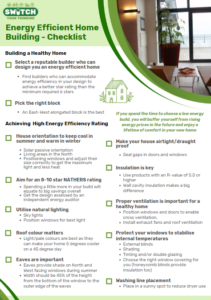Low Energy Building
Benefits of Low Energy
- Save money from low energy bills
- Contribute to energy security and affordability
- Reduced carbon emissions
- Improved comfortability and health of residents
- Reduced energy wastage for the wider community
- Assist in lowering the peak demand of energy

Plan ahead and checklist your builder.
Building a new home can be a stressful and confusing process. There are many builders, home designs and locations to choose from and ensuring your home is energy efficient is something that is often overlooked. Reference our ‘Building a Sustainable Home Checklist’ when you are talking to prospective builders for your build. This will ensure you don’t get bamboozled and you get the sustainable home of your dreams.
Sustainable Home Build Considerations
When you are planning your sustainable build, you should consider several aspects of you new home to minimise your impact during the build and whilst you are living in your new home. Why not aim for 10 star rated home for maximum thermal comfortability and low bills above the mandatory 7 star rating? You can save a lot when you get it right at the building stage!
- Passive Solar house with correct orientation
- Light coloured roofs make homes 5 degrees cooler on a 40 degree day!
- Position the windows to get warmth in winter and mild sun in summer
- Wider eaves keeps the house cooler
- High ceiling for better comfort in summer and a spacious look
- Solar panels and battery systems
- Invest in double glazed/e-glazed windows
- Draught proofing
Browse the tabs below to learn about specific tips for your next sustainable home build.
- Designing for Comfort
- Building Features
- Landscaping
- Smart Living
- Appliances & Tech
- Other Resources
Energy Transfer in Your Home
Heat transfer has a big impact on how often you need to cool your home in summer and heat your home in winter to keep it at a comfortable temperature. Energy, in the form of heat, moves into, around and through your home in three ways – conduction, convection and radiation.
Conduction
Heat energy transferred directly through a solid material. For example, a hot brick wall around a fireplace.
Convection
Heat energy transferred to or through a fluid or air. For example, warm air rising.
Radiant Heat
Heat energy transferred by electromagnetic waves. For example, sunlight heating bricks or roofing.
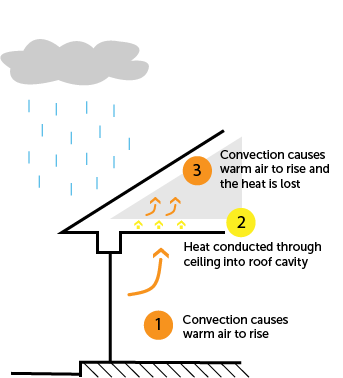
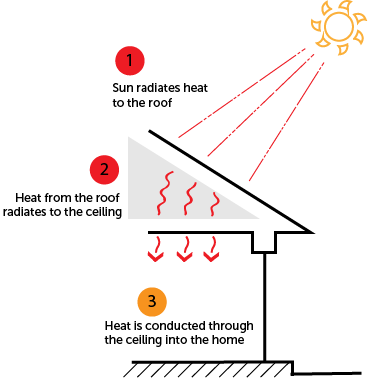
Thermal Mass
Thermal mass is the ability of a material to absorb and hold onto heat energy. Building products that have a high density, such as bricks and tiles, have a higher thermal mass than materials with a low density, such as timber. A brick wall will take longer to heat up than a timber wall, but it also takes longer to cool down once it is warm. Appropriate use of thermal mass can help reduce temperature fluctuations in your home and moderate temperatures throughout the seasons.
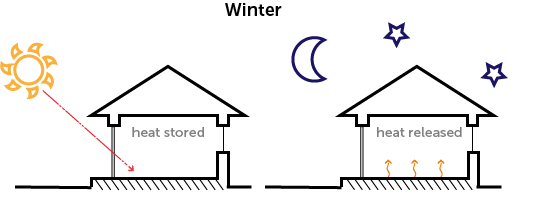
During winter, heat from the sun hits the tiled concrete floor, releasing the warmth overnight.
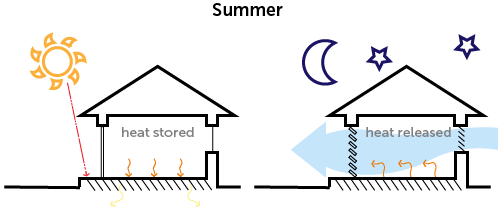
During summer, heat energy within the house is absorbed by the tiled concrete floor and released into the ground during the day.
Natural Ventilation
During summer, heat enters your home through walls, floors and from reflected sunlight transferred through glass surfaces. Your appliances and lighting also create heat within your home.
Hot air can be removed from your home by opening windows and doors during cooler evenings. Homes with open plan living spaces, security and fly screens allow for greater natural ventilation.
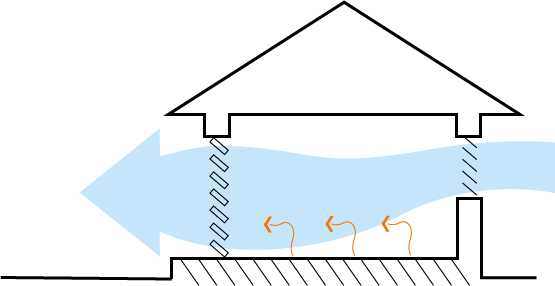
Allowing natural ventilation to flow through the house helps eliminate heat, cooling the temperature inside.
Warm in winter and cool in summer
The angle of the sun, in relation to the Earth’s surface, changes as the Earth moves around the sun throughout the year. In Perth, the angle of the sun is lower during mid winter (about 35° at noon) compared to mid summer (about 82° at noon).
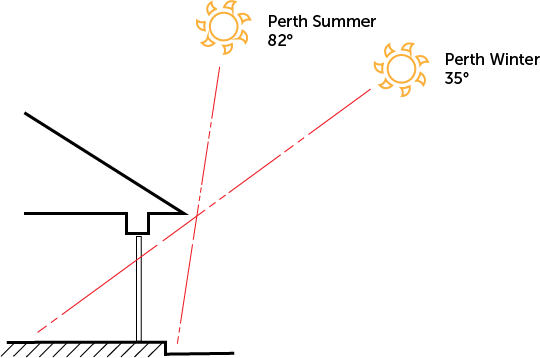
Maximise energy efficiency by orienting your home with living and entertaining areas to the north and minimal windows on the east and west sides. This will maximise exposure to the sun during winter, and reduce exposure during the summer.
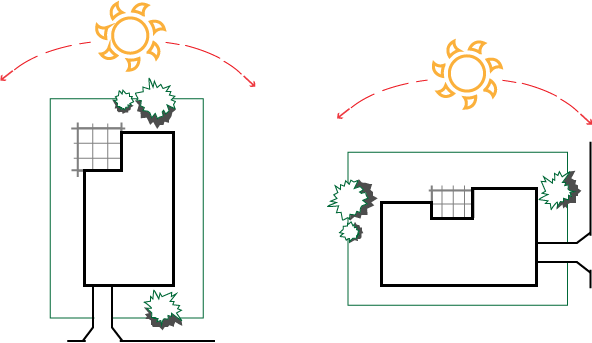
Patios and living spaces should be located on the northern side to maximise exposure to the sun during winter.
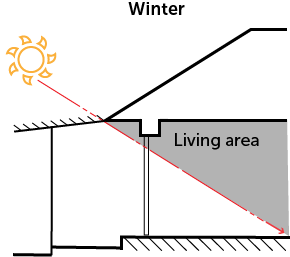
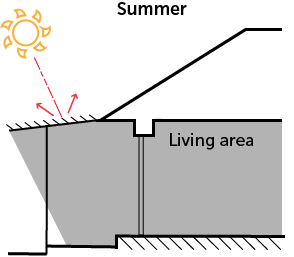
Adjustable louvres are set at an angle that blocks the suns heat in summer and allow warmth through in winter.
Much of the heat energy that enters your home through windows is reflected heat from hard surfaces such as paving. Eaves and overhangs generally don’t extend out far enough to block the heat that is bouncing in from hard surfaces surrounding the house, so shade structures should extend three metres from windows on the northern side of your home for maximum effectiveness.
There are several features of sustainable homes that make a big difference to energy consumption and therefore your carbon footprint.
Insulation
Insulation in walls, ceilings and lining underneath roofing material will help keep warmth in during winter and the sun’s radiant heat out during summer. Wall insulation is a great option for the standard double brick home. Fibreglass batts and blow-in insulation will deteriorate and sag over time so are not a good option for wall cavities, instead choose a foil backed insulation blanket. The reflective foil layer will hold the insulation in place and prevent sagging.
Tip: Take a look in your roof cavity and check that insulation has been installed correctly. We have heard many stories of people discovering that the insulation they paid for had never actually been installed!
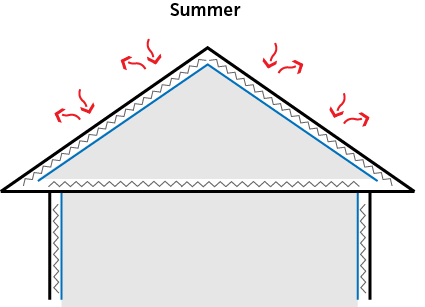
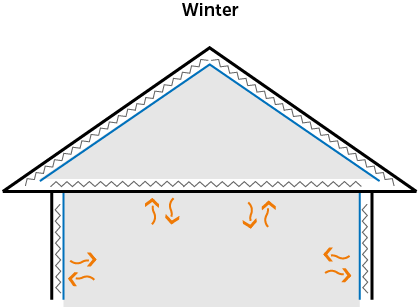
Insulation helps to block heat entering the house during summer and holds the warmth inside during winter.
Roof Colour
In general, a dark coloured roof absorbs more heat than a light coloured roof, this heat is transmitted into your house through convection and conduction which reduces the energy efficiency of your home in summer. This is especially relevant for concrete and terracotta tiles, which have a high thermal mass . Tiles continue to emit heat after the sun goes down, keeping your home hot through the night.
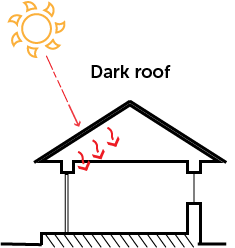
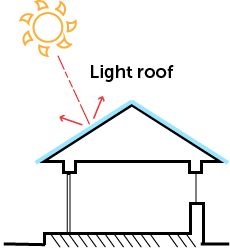
Doors and Windows
Orient doors and windows so that prevailing cool breezes are able to enter the home and flush out warm air before exiting on the opposite side. Openings should be larger at the exit point to ensure good ventilation. Sliding, louvre or casement windows offer far greater ventilation capacity than awning type windows. Security screens or fly screens installed in doorways and windows are important considerations to facilitate natural ventilation in the evenings and nights during summer.
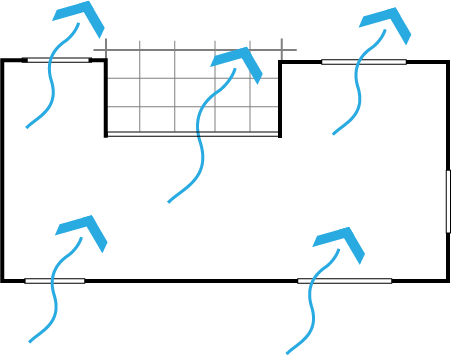
Curtains and Pelmets
Heavy, multilayered fabric curtains block summer heat convection. Maximise their effectiveness by ensuring they are snug fitting to prevent air from leaking out the sides. Pelmets trap an air layer between the curtain and window. Curtains can be opened to allow sunlight and warmth into the house during cool weather.
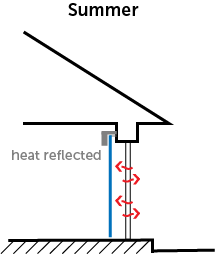
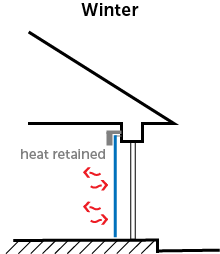
Awning Blinds and Roller Shutters
Awning blinds and roller shutters on the eastern and western sides of your house can block heat in summer and be opened at night to allow ventilation. Blinds and shutters can be left open in winter to allow heat to enter through windows.
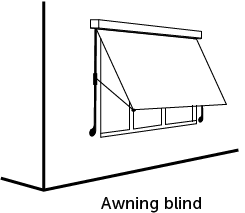
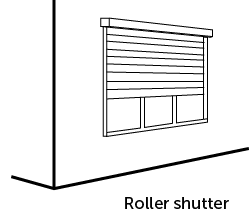
Trees, shrubs and groundcovers can improve the thermal performance of your home, create an appealing aesthetic, provide habitat for wildlife and can have positive mental health impacts.
Deciduous Trees
Deciduous trees and vines on the northern, eastern and western aspects of your home can be an effective way to block summer heat. Deciduous species lose their leaves before winter, allowing the sun through.
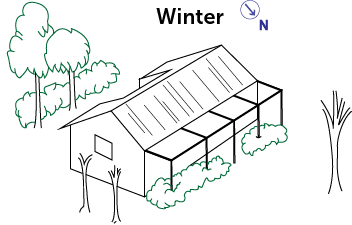
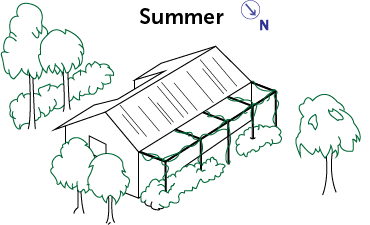
Deciduous vegetation blocks the sun’s heat during summer but allow it through in winter.
Wind Breaks
Thick shrubs and trees on the side of your home can form a windbreak from hot dry summer winds. Vegetation can also channel the prevailing cool summer breezes and dampen strong winds during storms.
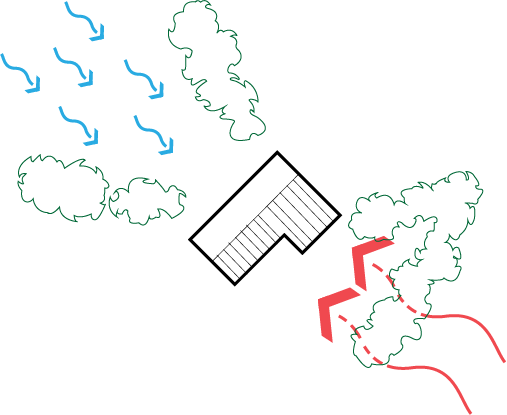
Gardens
Gardens also act like air conditioners, providing shade and cooling the environment. The soft, green surfaces don’t hold onto heat like bare sand or hard built surfaces. Vegetation can shield and cool walls, outdoor living spaces and windows.
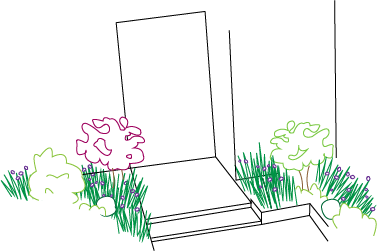
By taking control of your home’s climate control features, you can drastically reduce energy use, saving money as well as reducing the environmental impacts of your lifestyle. Some of the sustainable building and landscaping features outlined above require ongoing active management in order for them to function effectively and reduce your energy needs.
- Install 3 metre shade sails on northern aspect during summer, remove around April, once weather has cooled
- Open curtains to allow winter warmth in, closing curtains to block summer heat.
- Open windows in the evening to allow natural ventilation to cool the house and clear stale air during periods of hot weather.
- Adjust louvres to maximise shading in summer and to allow light and warmth through in winter.
- Regular pruning and maintenance of shade and wind break vegetation.
Consider what accessories, appliances and technology you install in your build to maximise your sustainability.
Ceiling Fans
Heating and cooling the home is the single biggest energy consumer in Australian households, accounting for about 40 percent of energy used. Ceiling fans work very effectively in Perth’s hot weather and reversible ceiling fans can also cycle warm air from the ceiling down during winter. Compared to an air conditioner, the energy use from a ceiling fan is negligible.
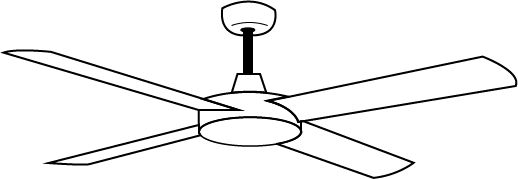
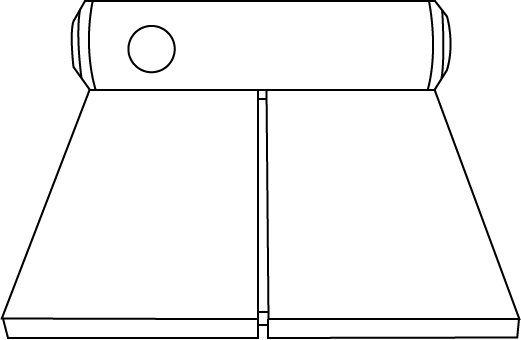
Solar Hot Water Systems
Heating water uses on average 21 percent of total household energy, making it the second biggest consumer of energy within Australian households.
Solar hot water systems are a great idea for any sustainable home in Perth. These systems absorb the suns warmth to directly heat water through a panel or series of tubes before it is stored in an insulated tank for later use. The systems are generally fitted with a booster that can heat water when there is insufficient sunlight.
Heat Pumps
Heat pumps use electricity to move heat from one place to another instead of generating heat directly. Quality heat pumps are extremely energy efficient; they work like a refrigerator, but use the heat rather than expel it. Heat pumps can be combined with photovoltaic systems to create a highly cost effective water heating solution.
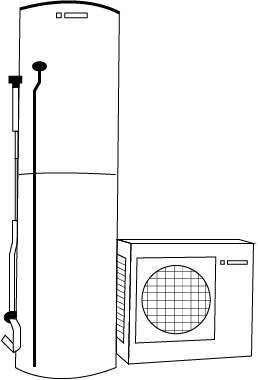
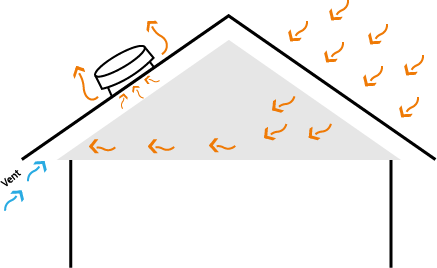
Solar Roof Ventilator
Roof ventilators move hot air out of the roof cavity to reduce the amount of trapped heat while the sun is shining. Generally they require wind to drive the process. Solar roof ventilators use inbuilt solar panels to power a fan that operates throughout the day, without wind. A mains power connection can allow the last hot air to be removed after the sun has gone down and a thermostat can prevent warm air being removed during cold weather.
Photovoltaic Energy System
Perth receives an abundant supply of sunlight throughout the year. A photovoltaic system (solar panels) will allow you to take greater control over your energy consumption. Solar panels provide cheap, renewable energy by converting sunlight into electricity. Battery storage technology allows even greater control, by supplying power after the sun has gone down.

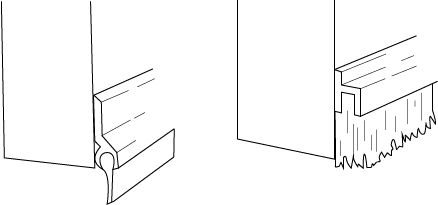
Weather Stripping
Greywater System
You can reuse the waste greywater from sinks, showers and washing machines on your garden. A simple reed bed treatment system can improve the quality of waste greywater before it is used more widely on the garden. A small scale treatment system can enable you to reuse treated greywater for toilet flushing and washing clothes.
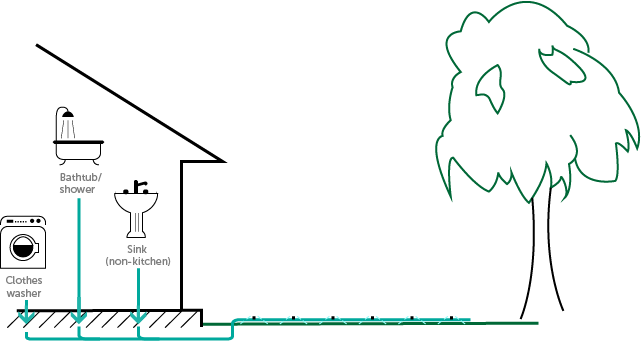
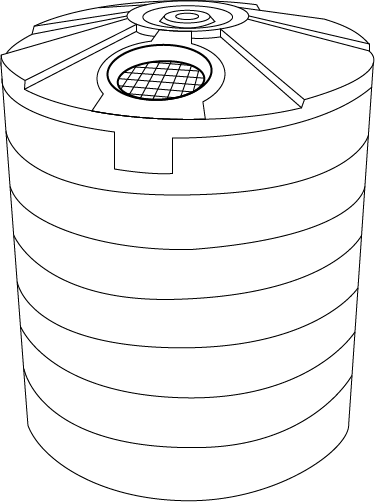
Rainwater System
Capturing and storing rainwater from your roof is a great way to reduce your use of treated scheme water. To determine the size of rainwater tank you will install, consider how much you will use the rainwater, how much space you have for a tank and how much rainwater you are likely to capture (Tankulator is a great online tool). If using rainwater for drinking, install a mesh filter to prevent leaves and large particles entering, as well as first flush system to reduce the risk of harmful bacteria, toxins and organic material entering your storage tank.
Checkout our Rewards for Residents for discounts on rain water tanks and other sustainable products.
- Designing for Comfort
- Building Features
- Cool Roofs
- Outdoors & Landscaping
- Smart Living
- Appliances & Tech
- Other Resources
Energy Transfer in Your Home
Heat transfer has a big impact on how often you need to cool your home in summer and heat your home in winter to keep it at a comfortable temperature. Energy, in the form of heat, moves into, around and through your home in three ways – conduction, convection and radiation.
Conduction
Heat energy transferred directly through a solid material. For example, a hot brick wall around a fireplace.
Convection
Heat energy transferred to or through a fluid or air. For example, warm air rising.
Radiant Heat
Heat energy transferred by electromagnetic waves. For example, sunlight heating bricks or roofing.
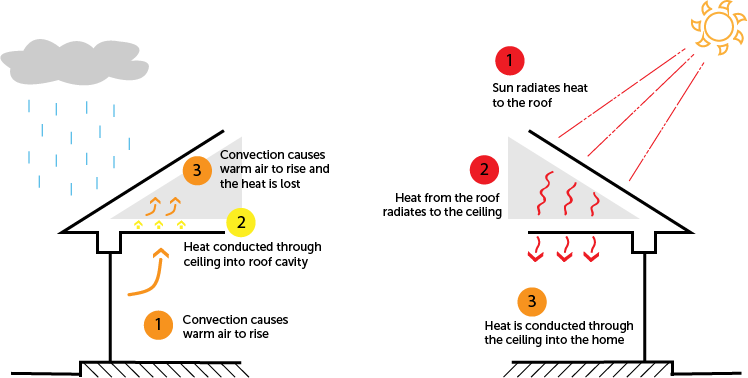
Thermal Mass
Thermal mass is the ability of a material to absorb and hold onto heat energy. Building products that have a high density, such as bricks and tiles, have a higher thermal mass than materials with a low density, such as timber. A brick wall will take longer to heat up than a timber wall, but it also takes longer to cool down once it is warm. Appropriate use of thermal mass can help reduce temperature fluctuations in your home and moderate temperatures throughout the seasons.

During winter, heat from the sun hits the tiled concrete floor, releasing the warmth overnight.
During summer, heat energy within the house is absorbed by the tiled concrete floor and released into the ground during the day.

Allowing natural ventilation to flow through the house helps eliminate heat, cooling the temperature inside.
Natural Ventilation
During summer, heat enters your home through walls, floors and from reflected sunlight transferred through glass surfaces. Your appliances and lighting also create heat within your home.
Hot air can be removed from your home by opening windows and doors during cooler evenings. Homes with open plan living spaces, security and fly screens allow for greater natural ventilation.
Warm in winter and cool in summer
The angle of the sun, in relation to the Earth’s surface, changes as the Earth moves around the sun throughout the year. In Perth, the angle of the sun is lower during mid winter (about 35° at noon) compared to mid summer (about 82° at noon).


Patios and living spaces should be located on the northern side to maximise exposure to the sun during winter.
Maximise energy efficiency by orienting your home with living and entertaining areas to the north and minimal windows on the east and west sides. This will maximise exposure to the sun during winter, and reduce exposure during the summer.
Smart shading techniques block heat from entering your home in summer, while allowing the sun’s warmth to enter your home during winter. Shade sails, adjustable louvres and deciduous vegetation can be used to block summer sun and then can be removed in winter to invite warmth into your home.
Much of the heat energy that enters your home through windows is reflected heat from hard surfaces such as paving. Eaves and overhangs generally don’t extend out far enough to block the heat that is bouncing in from hard surfaces surrounding the house, so shade structures should extend three metres from windows on the northern side of your home for maximum effectiveness.
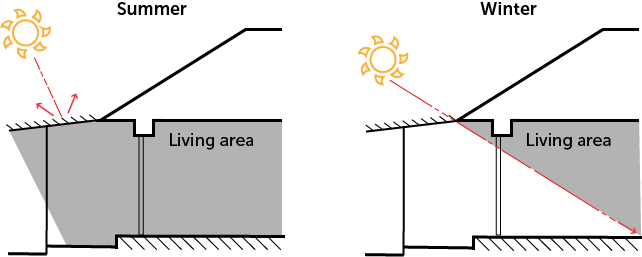
Adjustable louvres are set at an angle that blocks the suns heat in summer and allow warmth through in winter.
There are several features of sustainable homes that make a big difference to energy consumption and therefore your carbon footprint.
Insulation
Insulation in walls, ceilings and lining underneath roofing material will help keep warmth in during winter and the sun’s radiant heat out during summer. Wall insulation is a great option for the standard double brick home. Fibreglass batts and blow-in insulation will deteriorate and sag over time so are not a good option for wall cavities, instead choose a foil backed insulation blanket. The reflective foil layer will hold the insulation in place and prevent sagging.
Tip: Take a look in your roof cavity and check that insulation has been installed correctly. We have heard many stories of people discovering that the insulation they paid for had never actually been installed!

Insulation helps to block heat entering the house during summer and holds the warmth inside during winter.

Doors and Windows
Orient doors and windows so that prevailing cool breezes are able to enter the home and flush out warm air before exiting on the opposite side. Openings should be larger at the exit point to ensure good ventilation. Sliding, louvre or casement windows offer far greater ventilation capacity than awning type windows. Security screens or fly screens installed in doorways and windows are important considerations to facilitate natural ventilation in the evenings and nights during summer.
Curtains and Pelmets
Heavy, multilayered fabric curtains block summer heat convection. Maximise their effectiveness by ensuring they are snug fitting to prevent air from leaking out the sides. Pelmets trap an air layer between the curtain and window. Curtains can be opened to allow sunlight and warmth into the house during cool weather.
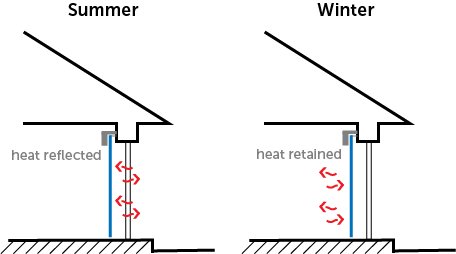
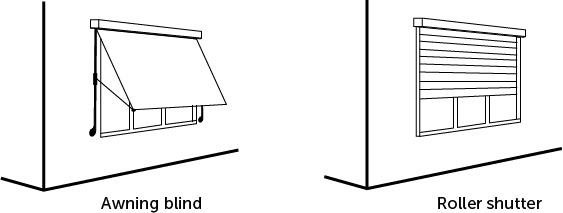
Awning Blinds and Roller Shutters
Awning blinds and roller shutters on the eastern and western sides of your house can block heat in summer and be opened at night to allow ventilation. Blinds and shutters can be left open in winter to allow heat to enter through windows.
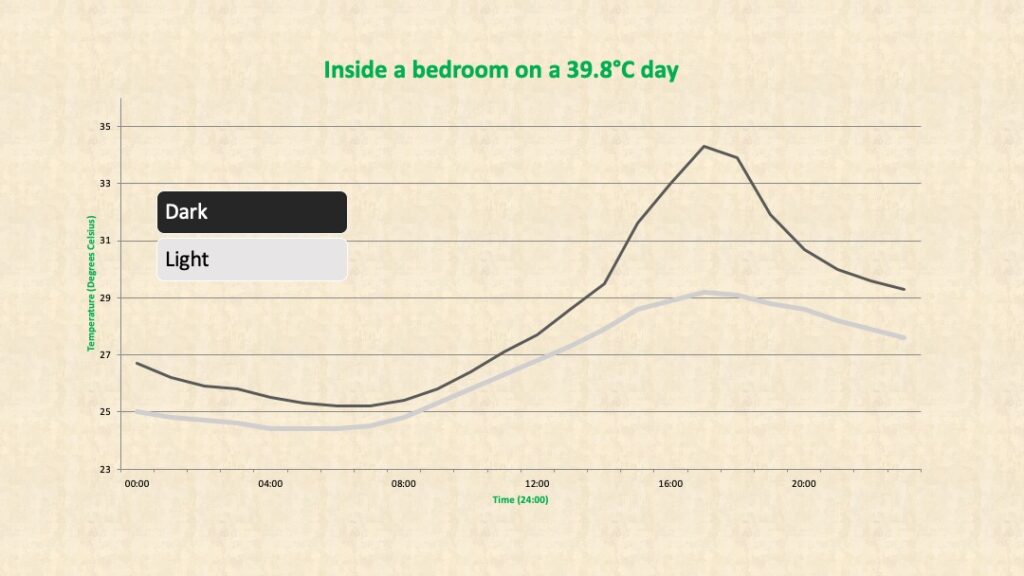
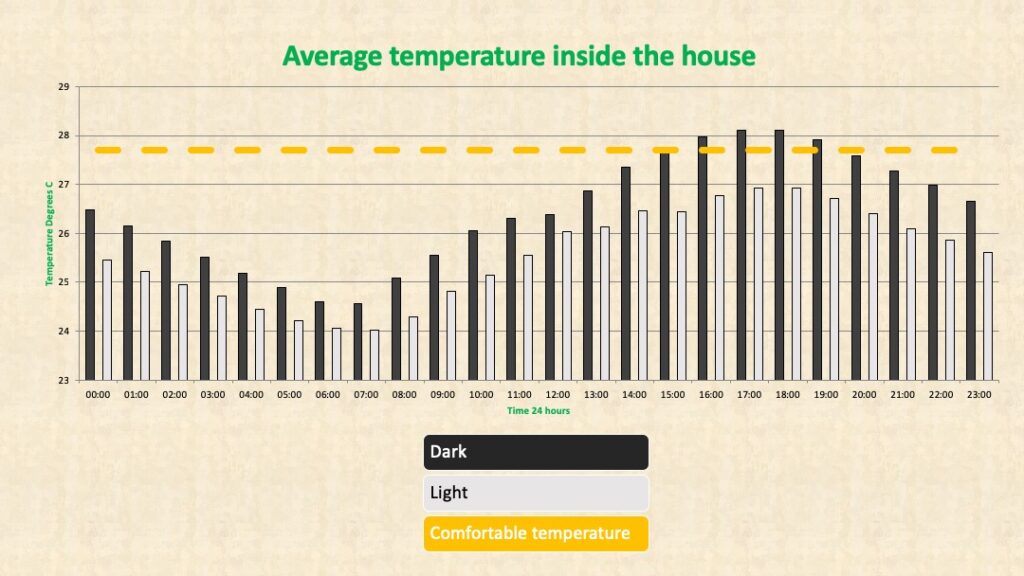
Trees, shrubs and groundcovers can improve the thermal performance of your home, create an appealing aesthetic, provide habitat for wildlife and can have positive mental health impacts.
Deciduous Trees
Deciduous trees and vines on the northern, eastern and western aspects of your home can be an effective way to block summer heat. Deciduous species lose their leaves before winter, allowing the sun through.

Deciduous vegetation blocks the sun’s heat during summer but allow it through in winter.

Wind Breaks
Thick shrubs and trees on the side of your home can form a windbreak from hot dry summer winds. Vegetation can also channel the prevailing cool summer breezes and dampen strong winds during storms.
Gardens
Gardens also act like air conditioners, providing shade and cooling the environment. The soft, green surfaces don’t hold onto heat like bare sand or hard built surfaces. Vegetation can shield and cool walls, outdoor living spaces and windows.

By taking control of your home’s climate control features, you can drastically reduce energy use, saving money as well as reducing the environmental impacts of your lifestyle. Some of the sustainable building and landscaping features outlined above require ongoing active management in order for them to function effectively and reduce your energy needs.
- Install 3 metre shade sails on northern aspect during summer, remove around April, once weather has cooled
- Open curtains to allow winter warmth in, closing curtains to block summer heat.
- Open windows in the evening to allow natural ventilation to cool the house and clear stale air during periods of hot weather.
- Adjust louvres to maximise shading in summer and to allow light and warmth through in winter.
- Regular pruning and maintenance of shade and wind break vegetation.
Consider what accessories, appliances and technology you install in your build to maximise your sustainability.
Ceiling Fans
Heating and cooling the home is the single biggest energy consumer in Australian households, accounting for about 40 percent of energy used. Ceiling fans work very effectively in Perth’s hot weather and reversible ceiling fans can also cycle warm air from the ceiling down during winter. Compared to an air conditioner, the energy use from a ceiling fan is negligible.


Solar Hot Water Systems
Heating water uses on average 21 percent of total household energy, making it the second biggest consumer of energy within Australian households.
Solar hot water systems are a great idea for any sustainable home in Perth. These systems absorb the suns warmth to directly heat water through a panel or series of tubes before it is stored in an insulated tank for later use. The systems are generally fitted with a booster that can heat water when there is insufficient sunlight.
Heat Pumps
Heat pumps use electricity to move heat from one place to another instead of generating heat directly. Quality heat pumps are extremely energy efficient; they work like a refrigerator, but use the heat rather than expel it. Heat pumps can be combined with photovoltaic systems to create a highly cost effective water heating solution.


Solar Roof Ventilator
Roof ventilators move hot air out of the roof cavity to reduce the amount of trapped heat while the sun is shining. Generally they require wind to drive the process. Solar roof ventilators use inbuilt solar panels to power a fan that operates throughout the day, without wind. A mains power connection can allow the last hot air to be removed after the sun has gone down and a thermostat can prevent warm air being removed during cold weather.
Photovoltaic Energy System
Perth receives an abundant supply of sunlight throughout the year. A photovoltaic system (solar panels) will allow you to take greater control over your energy consumption. Solar panels provide cheap, renewable energy by converting sunlight into electricity. Battery storage technology allows even greater control, by supplying power after the sun has gone down.


Weather Stripping
Greywater System
You can reuse the waste greywater from sinks, showers and washing machines on your garden. A simple reed bed treatment system can improve the quality of waste greywater before it is used more widely on the garden. A small scale treatment system can enable you to reuse treated greywater for toilet flushing and washing clothes.


Rainwater System
Capturing and storing rainwater from your roof is a great way to reduce your use of treated scheme water. To determine the size of rainwater tank you will install, consider how much you will use the rainwater, how much space you have for a tank and how much rainwater you are likely to capture (Tankulator is a great online tool). If using rainwater for drinking, install a mesh filter to prevent leaves and large particles entering, as well as first flush system to reduce the risk of harmful bacteria, toxins and organic material entering your storage tank.
Checkout our Rewards for Residents for discounts on rain water tanks and other sustainable products.
Other Ways to Switch
Learn about more ways you can switch your thinking and live a more sustainable lifestyle.

